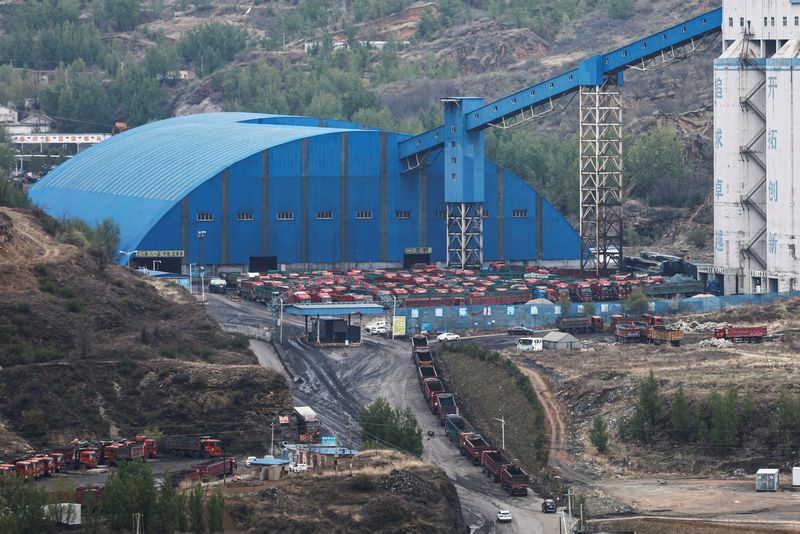By Clyde Russell
LAUNCESTON, Australia (Reuters) - China's imports of major commodities in 2024 presented a mixed bag, with record volumes of iron ore, coal and natural gas, but weakness in crude oil.
The raw data for the world's biggest buyer of natural resources suggests that parts of the economy are performing solidly, but others are struggling, or undergoing structural shifts.
However, the main challenge in analysing China's commodity imports is separating temporary factors from changes that are part of a long-term trend.
Crude oil is perhaps the best example of this.
Imports for 2024 were 553.42 million metric tons, according to customs data released on Monday. This is equivalent to 11.04 million barrels per day (bpd) and down 2.1%, or 210,000 bpd from 2023.
It's tempting to say that 2024 showed that the world's biggest importer of crude has reached its peak, and that 2025 and subsequent years will see lower arrivals.
The main reasoning for this is the rapid uptake to more than 50% of the market of what China calls New Energy Vehicles (NEVs), a term that groups both full electric vehicles and hybrids.
While the switch to NEVs is impressive and likely to continue at pace, it's worth noting that China's fleet of internal combustion engine cars is still increasing, so in theory so should demand for gasoline.
The picture for diesel is similar insofar as an alternative is eating away at the market share of the heavy transport fuel, with trucks powered by liquefied natural gas (LNG).
China's imports of natural gas, both as LNG and from pipelines, rose nearly 10% in 2024 to 131.69 million tons.
But perhaps the most important factor driving the lower crude oil imports is price, with benchmark Brent crude oil futures holding above $70 a barrel for all of 2024 apart from two days in September when it dipped briefly below this level.
The stability of crude prices this year reflects the output discipline of the OPEC+ group of exporters, who have cut an effective 5.5 million bpd from potential supply.
But it's also likely the case that China's refiners have taken the view that crude prices are higher than they ought to be, and they have scaled back their purchases accordingly.
IRON ORE, COAL RECORDS
On the flip side of weak crude imports amid high prices, it seems likely that record iron ore and coal imports were largely achieved on the back of lower costs.
Iron ore imports rose 4.9% in 2024 to 1.236 billion tons, a gain of 57.5 million tons.
The price of iron ore contracts traded on the Singapore Exchange had their 2024 peak very early in the year, hitting $143.60 a ton on Jan. 3.
They then declined to a low of $91.10 a ton by Sept. 10, before recovering to end the year at $103.61.
But the 28% drop over the year was likely enough to prompt Chinese steel mills and traders to increase purchases, especially in the second half of the year when prices were lower than in the first half.
It's also the case that China's steel mills weren't buying more iron ore because they were making more steel, with official data showing that crude steel output in the first 11 months of 2024 was 929.19 million tons, down 2.7% from the same period in 2023.
Rather, much of the extra iron ore went into stockpiles, with port inventories monitored by consultants SteelHome ending last year at 146.85 million tons, up from 114.5 million at the end of 2023.
Coal imports also hit a record high in 2024, reaching 542.7 million tons, up 14.4% from 2023's 474.42 million.
Coal demand rose amid lower hydropower generation and gains in electricity demand, but the main boost to imports was that seaborne prices were competitive with domestic output, thereby encouraging utilities, especially in the south of the country, to turn to supplies from Indonesia and Australia.
Indonesian coal with an energy content of 4,200 kilocalories per kg was assessed by commodity price reporting agency Argus at $49.97 a ton in the week to Dec. 30, down 13.5% for the year and lowest since April 2021.
STEADY COPPER
There was one major commodity that had a more steady 2024, and that was copper, with imports of unwrought copper rising a modest 3.3% to 5.68 million tons.
Since the record high of 6.68 million tons in 2020, China's copper imports have held in a fairly narrow range between 5.5 million and 5.87 million.
This is perhaps the best indicator of the true state of China's economy, given copper's essential role in both manufacturing and construction.

Copper imports point to slow growth momentum in the world's second-largest economy, as strong sectors such as NEVs and energy transition products such as solar panels aren't enough to offset weaker areas such as residential construction.
The views expressed here are those of the author, a columnist for Reuters.